'Shredded metal danger' in Hartlepool thanks to litter louts - the unwitting risk posed to children by those who drop rubbish


Concerns were raised over littering being a ‘huge problem’ in Hartlepool and how it can be impacted by council grass cutting.
In the questions from the public section of the latest Hartlepool Full Council meeting, a question was put to the chair of the Neighbourhood Services Committee by one Mr Feeney.
Advertisement
Hide AdAdvertisement
Hide AdThe resident said litter ‘littering is a huge problem’ in the borough, though adding a lot of ‘fantastic hard work is put in by the town’s small but passionate community of voluntary litter pickers’.
However he noted an issue that ‘regularly’ crops up is grass cutters slicing litter, and gave the example of a cans being ‘shredded into 20 small and sharp pieces’, posing a risk to children and meaning more work for volunteers.
Therefore it was asked if the public could have access to the council grass cutting schedule.
Council chiefs stressed operators are trained to check for and clear litter when cutting grass, noting cutting schedules mean they tend to visit most open spaces and verges between every 14 and 21 working days.
Advertisement
Hide AdAdvertisement
Hide AdCllr John Tennant, chair of the Neighbourhood Services Committee, said due to issues such as fluctuating weather conditions it would be impossible to provide a fixed timetable of grass cutting.
However he did note as a guide areas would be cut between every 14 and 21 days working days, and operators do try and pick up all litter where possible.
“We aim for approximately 14 cuts a year, but it can vary depending on the conditions,” he said.
“Because of fluctuating weather conditions it’s almost impossible to develop a fixed timetable or schedule for when a piece of ground will be cut.
“Operators are trained to check and clear litter as much as possible before mowing. Unfortunately this cannot guarantee everything is removed and litter can lay within the grass unseen.
Advertisement
Hide AdAdvertisement
Hide Ad“I would advise anyone concerned about timing a litter pick to consider the grass cutting return frequency. If it is getting close to 14 working days since the last grass cut of an area, there is high probability grass cutting machinery will be returning in the very near future.”
He also added sports pitches and bowling greens receive more cuts to ensure they are in a playable condition.